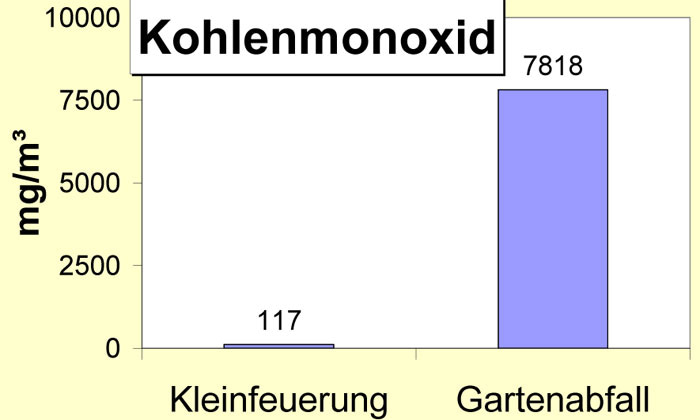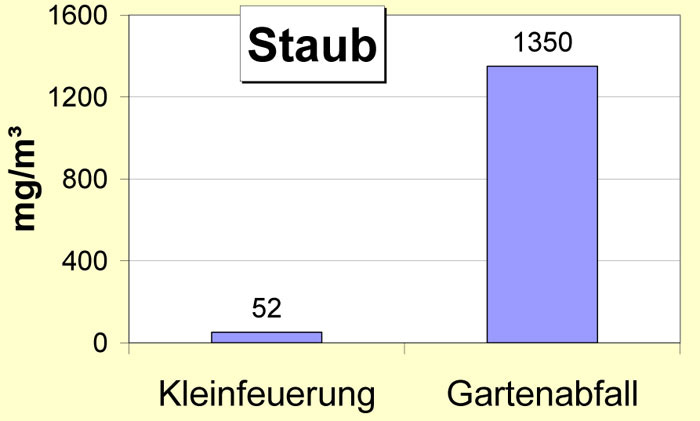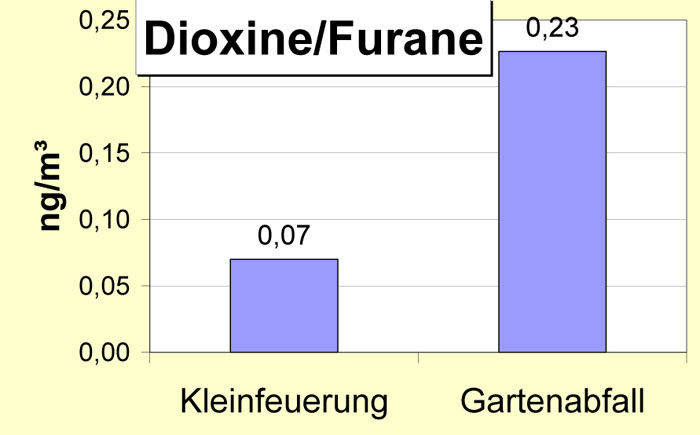Dangerous Mistakes
Many assume that burning green waste is harmless. This is a fatal mistake. One of many. Therefore, here are numbers, data and facts on the subject of particulate matter and nitrogen dioxide and what they have to do with garden waste.
Photo: Barbara Bartels-Leipold
Just water vapor?
A deadly mistake!
Unfortunately, the assumption that burning green waste is harmless is a common misconception. Combustion is only harmless to health if it is completely converted into carbon dioxide and water at high temperatures. For this purpose, the firing material may only have a maximum residual moisture content of 30%. Wood has to dry for one to three years protected from rain. Even complete combustion would be harmful to the climate.
Green waste from the garden or agriculture usually has a much higher moisture content. As a result, the combustion temperature is too low, the fire does not get enough oxygen and combustion is incomplete.
Poisonous mixture with fatal consequences
This leads to heavy smoke development, which produces toxins such as carbon monoxide and carcinogenic compounds such as polycyclic aromatic hydrocarbons (PAH; components of tar). When there is a fire, water vapor is indeed visible. However, pollutants attach themselves to this, as well as to the invisible fine dust particles, spread and rise into the atmosphere.
By way of illustration , scientists from the State Office for Environmental Protection in Halle (Germany) and the Institute of Fire Brigades have compared the exhaust gases from garden fires with those produced in a modern small-scale home heating system using straw pellets .
The concentration of the respiratory poison carbon monoxide was 67 times higher in the garden fires than in the pellet heating system. The content of benzo(a)pyrene, which is also found in cigarette smoke and is considered carcinogenic, was even 330 times higher in the exhaust gas from the garden fire than in the exhaust gas from the heating system.
The researchers also detected significantly increased concentrations of dioxins and furans, which can also cause cancer (see graphics below).
Initial results show that some pollutants, including carbon monoxide, benzo(a)pyrene, dust and dioxin, occur in very high concentrations in the flue gas. For example, the values for dust are around 25 times higher than in the case of controlled combustion of pelleted straw-like fuels in small combustion plants that are operated according to the state of the art. (Average values from test results from the Saxony-Anhalt State Office for Environmental Protection).
And the fields burn forever: pathogens from agriculture
The burning of green waste from agriculture has an even worse effect than fires in private gardens. What is burned there is even more problematic due to residues of pesticides.
A study commissioned by the Commission for Environmental Cooperation of Canada, Mexico and the United States shows that, depending on the fungicide or herbicide used, dioxin levels can be 150 or even 270 times higher than untreated biomass.
The concentrations of lung-damaging particulate matter ( PM10) are also significantly increased in open-air fires.
The State Office for Environmental Protection in Halle has proven that the exposure to fine dust on the burning days, i.e. on days on which the burning of garden waste is exceptionally permitted, exceeds the permissible limit values. Unfortunately, the burden of agricultural fires in rural areas has not yet been discussed in Spain.
A garden fire = particulate matter from 250 buses [
At the same time, environmental zones will be set up in cities such as Madrid or Barcelona, in which petrol or diesel vehicles will no longer be allowed to drive or only to a limited extent. A larger garden fire produces the same amount of soot and smoke particles (particulate matter) in six hours as 250 buses produce in a whole day.
numbers, data, facts
premature deaths from particulate matter in Spain 2019
premature deaths from particulate matter in Europe 2019
premature deaths from nitrogen dioxide (NO2) in Spain 2019
premature deaths from nitrogen dioxide (NO2) in Europe 2019
Source: Medical Journal/EU
Worth knowing about particulate matter
What is particulate matter?
When it comes to dust, most people think of solid particles that can make working around the house a torture. Its “big” brother is fine dust, which also occurs at home, but mainly outside.
This fine dust is a toxic mixture of tiny particles from different sources. A distinction is made between primary and secondary fine dust. Both can be from natural sources or man-made.
Primary means particulate matter that is produced directly during combustion processes. Secondary particulate matter is the product of other substances such as ammonia, sulfur and nitrogen oxides.
particulate matter categories
Particulate matter is widespread and can be contained in liquid and solid substances. Since it varies in size, it is divided into different categories. It is measured in µm (mu or microns). A micrometer = 1 thousandth of a millimeter.
PM10 is the largest particulate matter with a diameter of up to 10 µm (microns). This includes house dust, pollen and mold spores. There is a European limit for PM10.
PM2.5 is fine dust with a diameter of less than 2.5 µm, such as combustion particles, asbestos dust, but also bacteria. There is also a European limit value for PM2.5.
PM1 is ultrafine dust. It is so small that you can hardly imagine it, with a diameter of less than 1 µm. This includes soot particles, but also viruses.
How harmful is fine dust?
Even if fine dust sounds so harmless, it has serious health consequences. According to the World Health Organization (WHO), just ten micrograms of particulate matter per cubic meter of air can reduce the life expectancy of the entire population by an average of six months. Particulate matter is therefore one of the pollutants with the most far-reaching health effects.
The United Nations Environment Program also draws attention to the problem of air pollution. Likewise, the World Food Program , which specifically points out the health problems caused by agricultural fires around the world and advocates alternatives. And even the United Nations Human Rights Council has recognized the right to a clean environment as a human right and appointed a rapporteur.
How does fine dust work?
It’s not the size that matters, at least when it comes to particulate matter. The smaller the particles, the deeper they penetrate the body and the more dangerous they are to health.
This applies in particular to ultra-fine soot particles, which are even classified as carcinogenic. But asthma, allergies, cardiovascular and respiratory diseases can also be attributed to particulate matter.
How can fine dust be reduced?
Anyone can reduce fine dust: For example, leave the car at home or use electricity from renewable energies.
Here in Spain, however, one of the greatest potentials lies in no longer simply burning green waste in the fields.
Conclusion
A fire that smokes is poisonous, even if you only see the water vapor. In addition to CO2, a smoldering fire also releases toxins and pollutants such as carbon monoxide, dioxins, furans, benzo(a)pyrene and particulate matter. It damages the climate, the environment, humans and animals. It endangers the newly established human right to a clean environment, including the right to clean air, which is protected in the European Union by Directive 2008/50/EC on ambient air quality and clean air in Europe.





